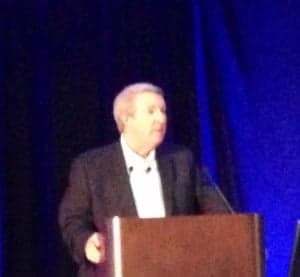Like yesterday's “live blog” post about the Autoliv talk, I also wrote this post as Art Byrne talked, but held it for publication today. He is author of the book The Lean Turnaround: How Business Leaders Use Lean Principles to Create Value and Transform Their Company and was my guest for episode #158 of my podcast.
What did Art say? What's below are quotes or close paraphrases (any comments I make will be in italics). If you're a healthcare person, please read this too, as the leadership lessons are universal (and see Virginia Mason Medical Center numbers at the end).
Opening Comments
“Only 5-7% are doing it the right way, the rest are sort of dabbling in it.”
I've always done this as CEO and it's always been a business strategy. Why do people think this is a bunch of tools? That never occurred to me that Lean is tools.
The way we look at a business is backwards. We take the value-added work for granted, including things like lead time, etc.
We all focus on “make the month.” What is “the month?” What are you so focused on? The month isn't real – it's a number (or a wish) that you made up a year ago when you made the budget. It's already occurred. You can't do anything about it. You're analyzing last month and this month is already going off the rails – driving the car through the rear-view mirror.
Value is created by improving your own VA activities so it can be of benefit to the customers.
Lean helps you conform to your customers' needs as opposed to the other way around – opposite of the typical approach. Lean is the best value creator that's ever been invented. It's simple, it's not capital intensive, but you get huge gains in your own VA activities so you grow and gain market share. Along the way, you'll get a lot of productivity. Lean is the best productivity tool ever created… but we messed it up.
JIT, TPS, and Lean
In 1982, the word Lean wasn't invented yet (1996)… it was “just in time” that we heard first. One pillar of the TPS (along with jidoka). We didn't think of that, it was just “JIT / inventory” and the big guys thought “beat the hell out of your suppliers” instead of reducing it across the entire supply chain.
Lean was a better term than TPS or JIT. But it was generally just called “lean manufacturing which is a big tragedy. Why would you adopt this if you're not in manufacturing then? Even in manufacturing companies, it's a disaster to call it “lean manufacturing.” Most CEOs would delegate or dump that on their VP of Ops – disaster.
Art talks about Lean – why, what, how?
Why? You're running a business and you want good results.
When he was CEO, Wiremold results included:
- Sales quadrupled
- Gross profit up from 38% to 51%
- Operating income up 13x
- EDITDA grew from 6% to 20%
- Inventory turns from 3x to 18x
- Machine changeovers from 3 per week to 20-30 per day
- Lead times from 4-6 weeks to 1-2 days
If you're running a business and not interested in Lean, then you're in the wrong job.
I'm sitting next to a CEO who is thankfully taking copious notes.
Why isn't everybody doing this? People say “but we don't believe the numbers” or “we're pretty busy with this new ERP system, etc…. maybe later.”
You're TOO BUSY to get better? That's what you think?
Why does Toyota share this system? Iwata said, “I can tell you, I can show you, but I bet you can't do it.”
Easy to say, hard to do.
You need a proven approach — leadership = the key ingredient.
After there were writeups about Wiremold, lots of people wanted to visit. “You can't visit unless you bring your CEO.” They did this to attract leaders, not “industrial tourists.”
John Toussaint and the ThedaCare Center for Healthcare Value has the same rule – must bring the CEO!
Management Principles:
1) Lean is the strategy
This is really hard for some people to get because they think of Lean as tools. “The kanban tool might fit our culture… we'll put kanban on all of our batches and say that we're lean.”
Black belts? This isn't a karate class, we're trying to run a business.
Focus on your processes – not results.
Improve your strategic options by having shorter lead time.
Operational excellence is the core strategy. You don't have to give up on the things you think are strategic now. By reducing lead time, your options for doing other strategic things improve.
Which company will perform better and have more options? One hour setup vs one minute setup? This isn't just manufacturing, it's a strategic thing. Who will have lower cost and better quality?
2) Lead from the top
You can't just send a memo. You've got to lead it. Show them by example, do it on the shop floor. Learn by doing.
I can explain Lean to you in 20 minutes, but you don't learn anything unless you go and do it.
You don't have to BE a lean expert to lead a lean turnaround. You just have to be COMMITTED to becoming one.
3) Transform the people
If you respect your people, you'll understand ALL the good ideas for improving will come from the people who do the work. DUH! Nobody's listened to the employees forever. Start listening to them and get a big result. Get people engaged and working on improvement – create that culture.
If you can make Lean your culture, you're a very hard company to compete against.
Other Thoughts & Tips
WARNING: Never start a lean turnaround for INTERNAL reasons. You should be doing this for customers.
“But I want to cut headcount.” That's not focused on customers.
I've never seen anybody read just a few books and be successful with Lean. You need coaching to get you through the hard times (outside consultant or an internal group that you hire).
The Wiremold strategy will work in ANY industry. But people won't do it.
1) Constantly strengthen our base operations (time-based competition)
2) Double in size every 3 to 5 years (selective acquisitions and faster new product introduction). Related to 20% productivity gain and needed to keep people employed.
Kaizen is the approach for solving our customers' problems. Core values = people, customers, Kaizen.
As the CEO, “everything you do has to change.” Can't be delegated to a VP of Ops. Sales and finance functions need to change too. Changed the terms by which their customers paid… flattened out the order rate and cashflow was better.
You can't lay people off with Lean. But, most companies are 25-40% overstaffed. They got 30% to leave through EARLY RETIREMENT before doing any Kaizen. Do layoffs UP FRONT if you have to do them.
CEO must lead. Kaizen is a full time job. CEO must pick the Kaizen Events based on the business needs and results. CEO must set stretch goals (this is a problem for a lot of leaders… they are afraid of discouraging their people). But stretch goals show respect for your people and that you believe in them. Challenge a team with something big and they're sure they can't do it. When they beat it, you won't believe how good they feel.
A Kaizen event is not a planning exercise, it's a doing exercise. You should be moving equipment on the first day in a factory.
What is the Lean Leader's Role?
Make the case for change
Get everyone on board – middle managers and finance people are the biggest “concrete heads.
Implement strategy deployment. Biggest benefit is DE-selecting the things you shouldn't do. Can't have ten #1 priorities.
Take the leaps of faith when they come up. He agreed that “whatever Shingijutsu (consultants) said, we'll do it” and it generally worked out fine (even if they didn't think it would).
You should get the ideas of all 1,000 employees… you'll beat a competitor who is only getting ideas from the top 25 people. Respect and support your associates.
Help create the future leaders. Don't let things go back if the CEO leaves – develop future leaders. The CEO must be the Lean zealot (or whatever person is responsible for an area).
You've gotta get rid of standard cost accounting – it drives all of the wrong old habits and tells you all the wrong stuff.
Stop doing the 5-8 day review of the previous month. Spend the time visiting customers instead of justifying “the story” for last month. Stop writing the 25-page monthly plant report. He told a plant manager, “If you really like creating it, keep doing it. I'll guarantee you we'll never read it. We'd rather have you out in the shop floor.”
“I love profit sharing with Lean.” When a guy who used to run one machine now runs ten, he gains. Keep your finance guy out of setting this up, since they don't want to share anything or will create something too complicated.
Lean is great for acquisitions – provides the cash, lowers the risk. They'd start a Kaizen event on the first day of owning a new company.
Virginia Mason came and visited Wiremold for two days to learn Lean. Nurses now spend 90% of time with patients instead of 35%. Cases per day up 60% in a surgery center. Margin went from $1M in 2000 to $41M in 2010.
“If you don't try something, no knowledge will visit you.” – Chihiro Nikao (said to Art)
Please scroll down (or click) to post a comment. Connect with me on LinkedIn.
Let’s build a culture of continuous improvement and psychological safety—together. If you're a leader aiming for lasting change (not just more projects), I help organizations:
- Engage people at all levels in sustainable improvement
- Shift from fear of mistakes to learning from them
- Apply Lean thinking in practical, people-centered ways
Interested in coaching or a keynote talk? Let’s talk.










“…leadership lessons are universal.” Indeed they are. Leaders have a fabulous role model to imitate in Art. If they can change their leadership thinking and routines, then will help others do the same. See http://www.bobemiliani.com/lean-leadership-news/
Art’s angle on Lean leadership starting with the CEO and not being delegated to a VP of Ops…that might be a life-changer for me.
Makes my head spin and goosebumps pop up on my arms!
Wouldn’t it be a game-changer to work for him, or someone like him?
Could you imagine the results if a hospital could convince Art to take the CEO job for 3 to 5 years to get things righted?
Looking forward to having Art come to Iowa tomorrow.
How did that go?
I wasn’t able to attend. However, if it was anything like you described above, I’m sure it went well.
Mark,
I am glad my pen didn’t run out of ink setting next to you during Art’s presentation. I know Art is not a consultant. but there must be a way to package his presentation more fully to make it available to more of us in the CEO role.
Best Regards,
Steve
Steve – thanks for commenting. It was nice meeting you there. It would be great to have more CEOs at these Lean events. Hopefully Art’s book will be widely read. You can also share the podcast episode where Art tells much of this same story:
https://www.leanblog.org/158